I don’t actually remember the first time I slept in a tent.
Growing up, we were the kind of outdoorsy family that went fishing and hiking, but not backpacking or camping. And to be fair, much of our outdoor time together was spent in Montana, where tents were merely handy snack packs ready for Grizzly Bears to rip open with their claws. Or, so my mother (and Night of the Grizzlies) would have had me believe.
I have a vague memory of sleeping outdoors at summer camp in 5th grade—is it possible we cowboy camped?—and scant memories of rustic cabins at girl scout camp. I have a memory of tent camping on a high school church youth group mountain biking trip to Utah, as well as a memory of moving the tents in the middle of the night due to (non-dangerous, but highly inconvenient) flash flooding.
Once Beau and I started dating, camping and hiking were woven into our story from the beginning. He’d worked as a camp counselor in the rockies, giving him both skills and confidence that I lacked. We put a tent on our wedding registry, and some of our first married purchases were our sleeping bags. (Although that was in part a guilt purchase on my part, after I ruined his sleeping bag through the well-intentioned act of washing it in the laundry machine. Look, I was one of those kids who was spoiled out of everyday chores growing up and didn’t learn to do laundry until I went to college. I didn’t realize that a laundry machine could break things.)1
Since then we’ve had a whole lifecycle of tents that have taken us from coast to coast and back again.
Today, at this precise moment in our lives, when we can travel the world for a year with only 30l backpacks, and we can fit all our earthly possessions into a 5’x10’ storage unit, we own six tents. Six.
Perhaps it’s logical for someone as nomadic as I’ve become to have such wealth in portable homes.

Our Eddie Bauer wedding gift tent took us from Colorado to South Carolina, and our one-and-only trip into the woods during our year in that state.
Tragically, we never actually tent camped during our subsequent three years in Washington State. We lived on the Kitsap peninsula, and we hiked, explored, skiied, and made the most of our time there (despite the fact that Beau was gone more than he was home, and his schedule was punishing to the point that he has very few memories of those years.)
It wasn’t until we were back on the east coast, far from the mountains that we loved and the wild spaces that called us, that tents began to step into prominence in our lives.
Around 2010, when Beau got out of the military, we took a lengthy road trip across the country and through Colorado, Utah, Arizona and back up and east through Wyoming and South Dakota. Because this was the time before cell phone cameras (at least those worth anything) and Google Photos, when our computer crashed in Colorado we lost many early photos from that trip. But, those that remain include this shot of our magical camping spot south of Moab, which we found down a dirt road far south of town after showing up and finding every campsite (and hotel room) in Moab booked. I had a hazy recollection of seeing a campsites sign on our drive north from Monticello; if nothing else, we figured we could find some open land to camp on once we were out of town. We didn’t expect to wake up to red rock views, but we were sure happy when we did. It wasn’t the first time or the last we were grateful for the flexibility of our canvas home and the ability to pitch a place to sleep anywhere we could find one.
Our Marmot tent served us well for sleeping side-by-side with our two huskies, Shadow & Sierra, who joined us on this trip and many future ones, including a memorable campsite in Missouri where we were awoken by lowing cows (which would have been fine, had we realized we were camping on open range land. As it happened, it was a bit of a surprise.) And, it served a suitable sleeping pod for one of Beau’s early ultras, in this case the Montour 24 Endurance Run in Danville, PA.
Around this time, we started to make weekend trips to Shenandoah Park and the Appalachian trail. Seeking any excuse to escape from the urban bustle of Washington D.C., and often in pursuit of longer hikes for trail running, ultra training, or just pure enjoyment, we regularly headed a few hours west. So it made sense that at this time, we also invested in our lightweight backpacking tent (although all my photos of it date from later trips)

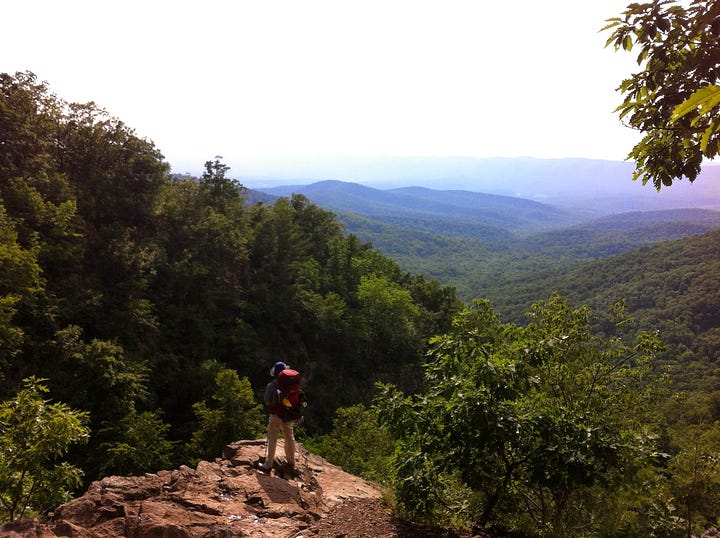

In 2017, we headed west for good. Around the same time, we upgraded our Marmot tent to a four-season North Face Dome tent, which we love but is also the hardest tent to assemble we’ve ever had. If you’re a newbie camper or you don’t manage procedural conflict well in your relationship, maybe stick with another brand? (In retrospect, we would have been nearly as happy keeping our Marmot tent. Oh well. You live, you learn.)
This tent has taken us mushroom hunting, ultra racing, and and festival camping. While it’s currently in rest mode, I have no doubt it will soon come out and accompany us on a range of New Mexico adventures. Our backpacking tent also showed its mettle in campsites across the rocky mountain west, and continues to be a favorite (despite being super cozy for two fairly average-sized adults).



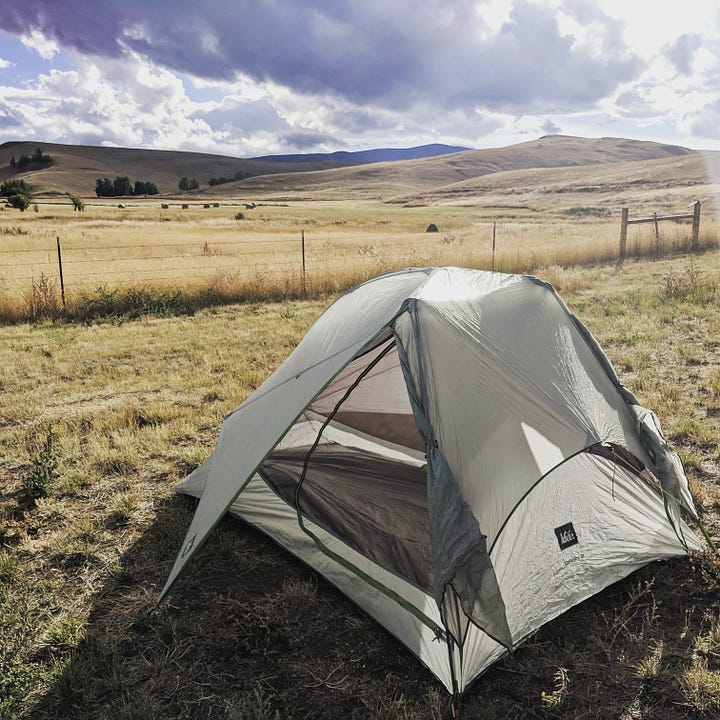
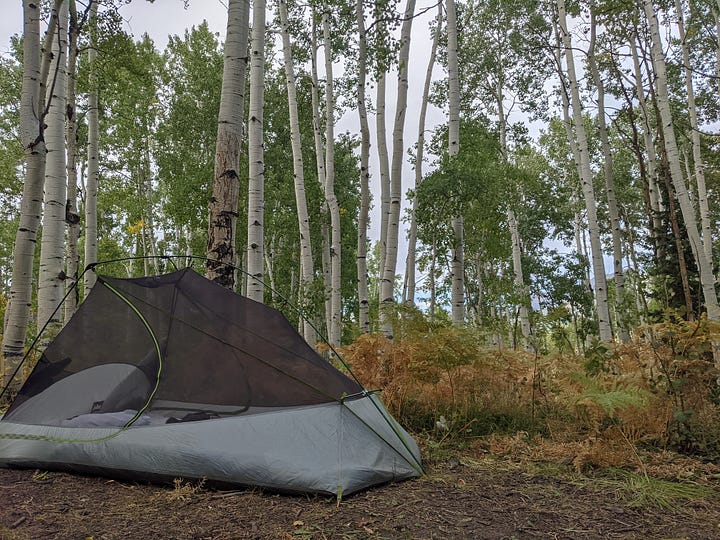
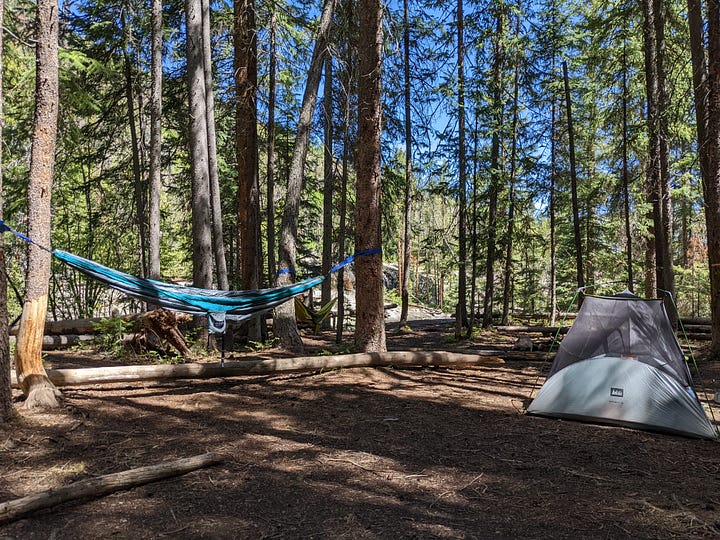
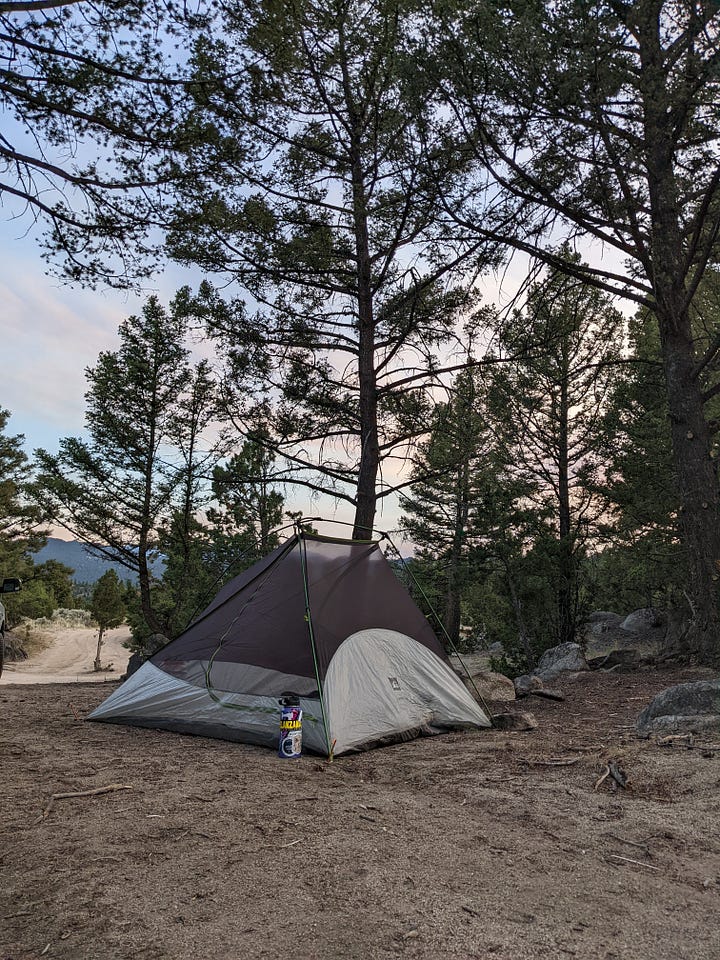
As proud owners of a quality four-season tent and a tried & tested backpacking tent from two of the top brands in outdoor adventuring, what more could we need, you ask?
Allow me to introduce you to the beast. The all-star. The VIP.
We bought this $150 Ozark Trail blackout tent from Wal-Mart on a whim in 2019. We were preparing for Beau’s second Across The Years race, and after the previous year’s rain and flooding we knew we wanted a dedicated tent with lots of room for sleeping and crewing. But, we didn’t want to spend too much on it, figuring we’d use it over the 10 day ultra and then likely sell or donate it (if it held together that long.)
Friends, this tent is worth every dollar spent and then some. It was exactly what we needed for the 10 day ultra experience. Then, we took it antelope hunting in southwestern Montana. And on a road trip through the southwest. And most recently, it housed us on our very first night at our new home here in New Mexico. These days, it’s our dedicated kitchen tent. It’s taken a beating from the high winds and the snow and the rain, and it’s in nearly as good shape as it was the day we bought it. This is in no way a sponsored post, but I’m here to tell you: I’m tempted to buy another one (or three) and just put them in storage. Because this tent goes the distance.
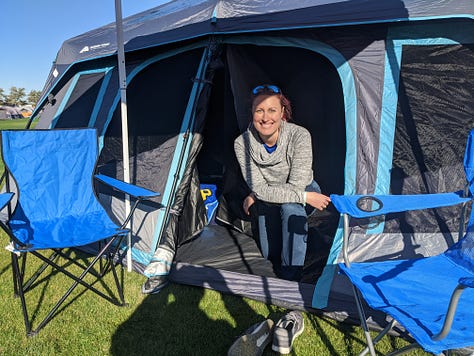



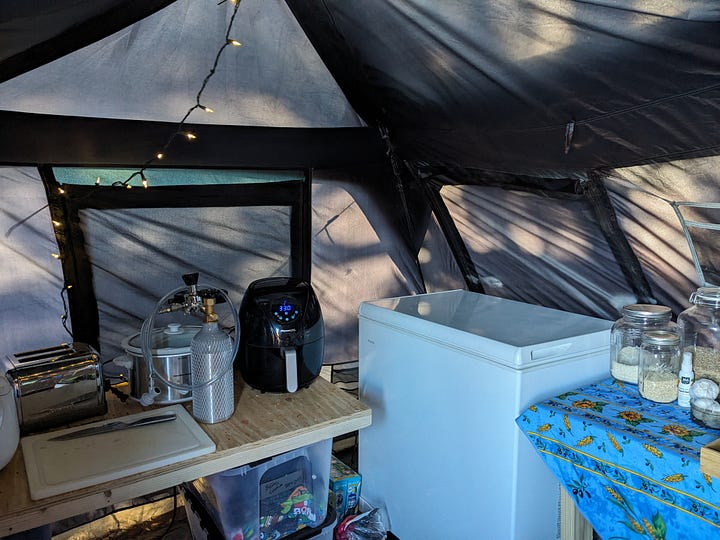
If you’ve been keeping track, we’re now up to three of the six tents we currently own.
Tent four is a bit of an outlier. Technically, yes, it’s a tent. But it also serves a much more specific purpose and, like our backpacking tent, it’s currently packed away. With our plans for our new Earthship and the built-in greenhouse, it may not even get much use in the future. But for now, we’re holding onto it. It’s our hydroponics tent.2

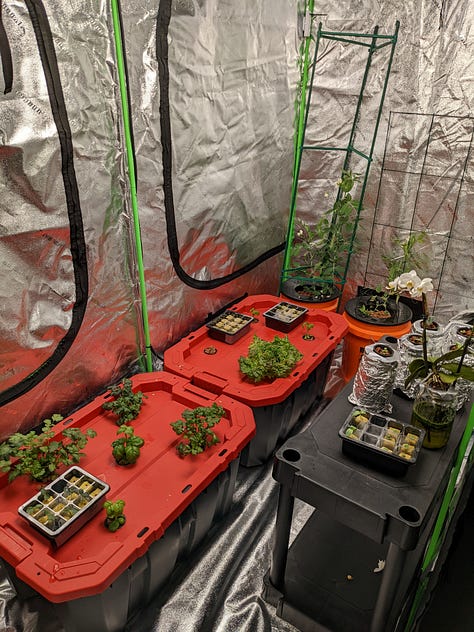
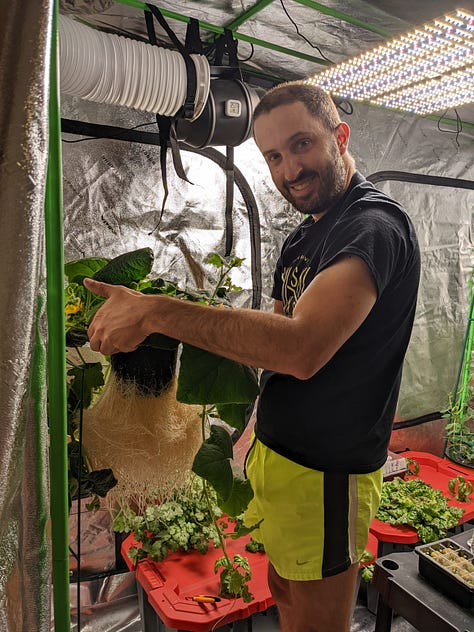
That leaves us with two final tents. One, a temporary solution that we’re holding onto for now, but housed us for the first few weeks on our land before our final tent arrived. Having had such success with our Ozark Trail Blackout Tent, we decided to try one of their other models—the yurt tent. It was fine, but in retrospect, I would have just purchased another Blackout model. The yurt tent feels flimsier and, while the high center is a nice perk, it felt smaller overall and not as useful as the Blackout tent was.
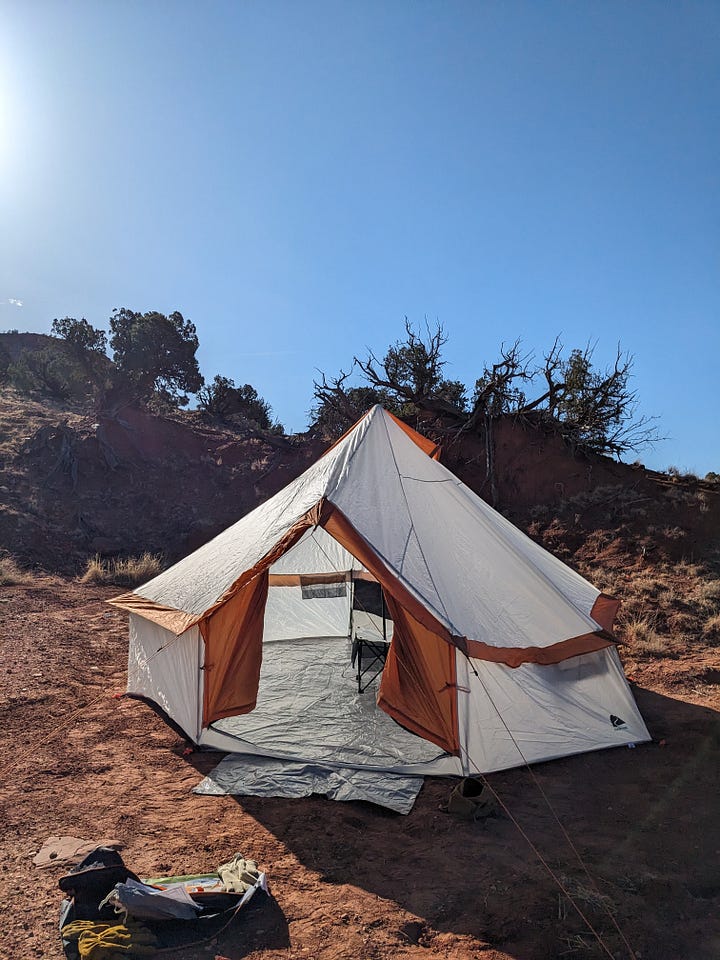

All of which brings us to our deluxe, glamping, current home.
When we were contemplating temporary lodging on our land, we knew we needed a place to call home for about six or seven months, until we would have the primary building work complete on our new home. We considered buying a used RV, but the cost/value ratio felt a bit ridiculous. We looked into geodesic domes, which are beautiful and structurally sound, but also expensive and more difficult to set up in a temporary capacity. We considered what we needed to be reasonably comfortable.3 And we got curious—what if we used a tent?
Not just any tent, but a robust, expedition-style tent like those used at glamping resorts around the world. A tent designed for high winds, and heavy rains, and a whole range of temperatures.
So, welcome to our current home: our White Duck 20’ Avalon canvas bell tent. Add a queen-size bed, a desk, a rug or two, and (because I melt in higher temperatures) a mobile AC unit. We’ve added an awning, and our bluetooth speaker plays our morning coffee playlist. An Ikea star pendant turns on at dusk and gives a soft glow as we ease into our evening routine. It’s already a cozy home for us, and we’ll likely keep it set up as a space for visitors in the future.
I’ve been thinking a lot about how we define home, not just lately but for quite awhile, which is perhaps obvious if you’ve been reading along with me for any amount of time. I’ve written about being homefree, of choosing where to live when you can live anywhere on the road, of being a traveler rather than a settler, and of finding a home that fits the shape of your soul. It’s become a running joke between Beau and I to call ourselves “Titanium Homeless” — because while we may lack things like running water and are currently living in a tent, we also enjoy the perks of being Titanium Elite members of the Marriott loyalty program. We stay at swanky resorts and enjoy perks in Malaysia and Singapore. We huddle under electric blankets in the winter desert. We embrace these dualities in our search for the life of our dreams. We are not homeless. We have a home. We simply choose to define it differently than most.
My recent reflections have been influenced in no small part by the memoirs of Raynor Winn. While our story is not theirs, I’ve seen echoes of our experience in that of Ray and her husband Moth: their struggle with literal homelessness a much more serious plight than our fluid approach to where we live; their fight against diagnosed degenerative disease a much more defined struggle than our health mysteries of the past few years. But while the degree and the scale of our experiences differ, I see much in common at the heart of our stories. So as I wrap up this post that is ostensibly about canvas and nylon, but in reality about where we sleep and how we live and the places we claim for our own very unique adventures, I’ll leave you with this quote from Winn’s memoir The Salt Path:
“At last I understood what homelessness had done for me. It had taken every material thing that I had and left me stripped bare, a blank page at the end of a partly written book. It had also given me a choice, either to leave that page blank or to keep writing the story with hope. I chose hope.
Now, go check out that Blackout tent. Maybe buy one for your family. Seriously.
Paid supporters ($6/month or $60/year) receive my 2024 series “Winter is Coming” in addition to my regular posts which are available to all subscribers for the first week after publication. If you would like to support my writing but would prefer to avoid a subscription model or paying through this platform, you can also support me by buying me a (virtual) coffee or sharing my writing with a friend.
Some of the links in this newsletter are affiliate links. When you click and shop at these links, I earn a small commission.
This continues to be one of the longest running points of contention in our marriage. I don’t know that I’ve ever been fully forgiven for destroying “the precious”.
Even though we’ve lived in multiple states where we could legally grow certain other things in our hydroponics tent, we haven’t. We’re just deeply committed to arugula and everyday greens & veggies.
Our definition of this phrase has broadened significantly over the past decade.






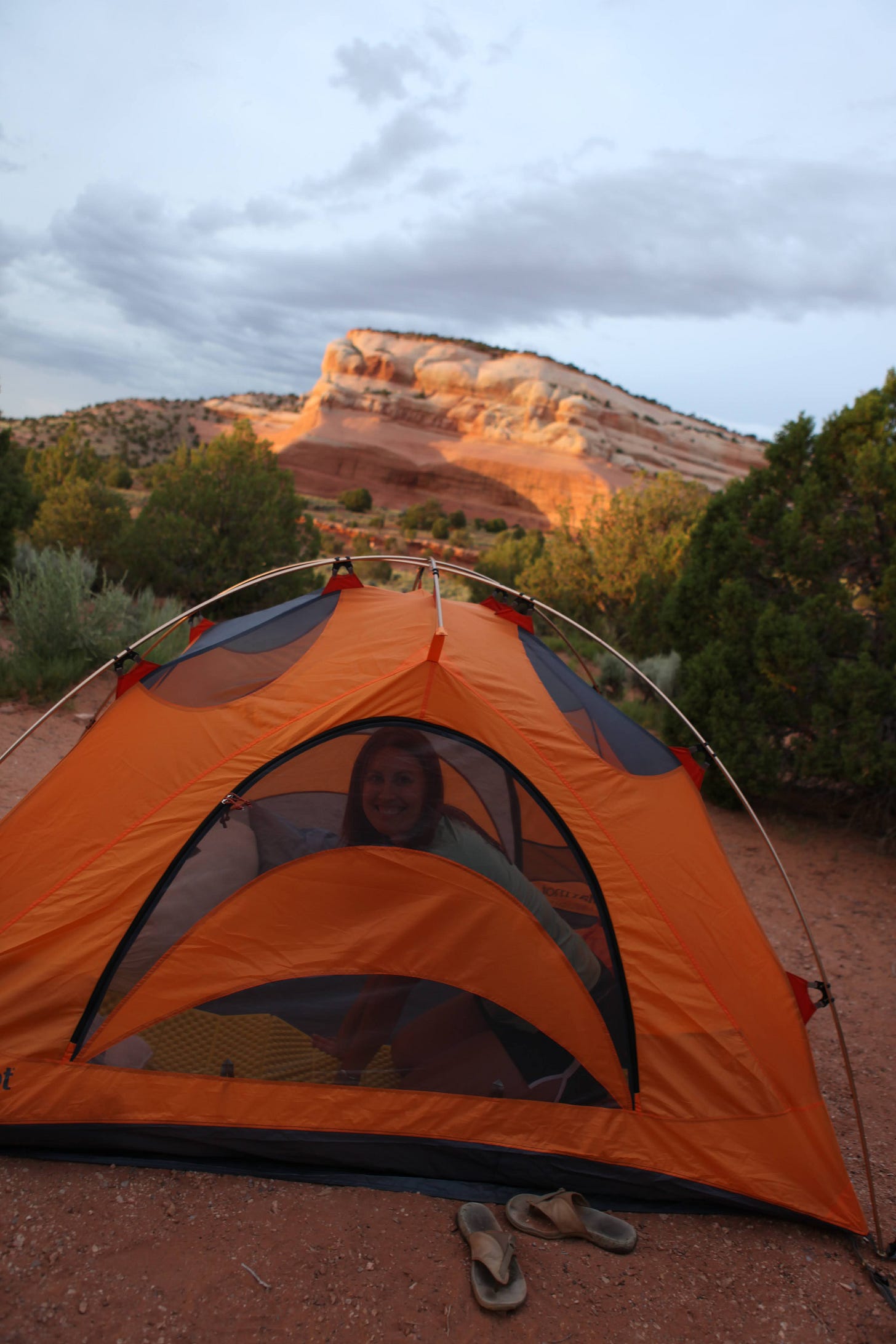

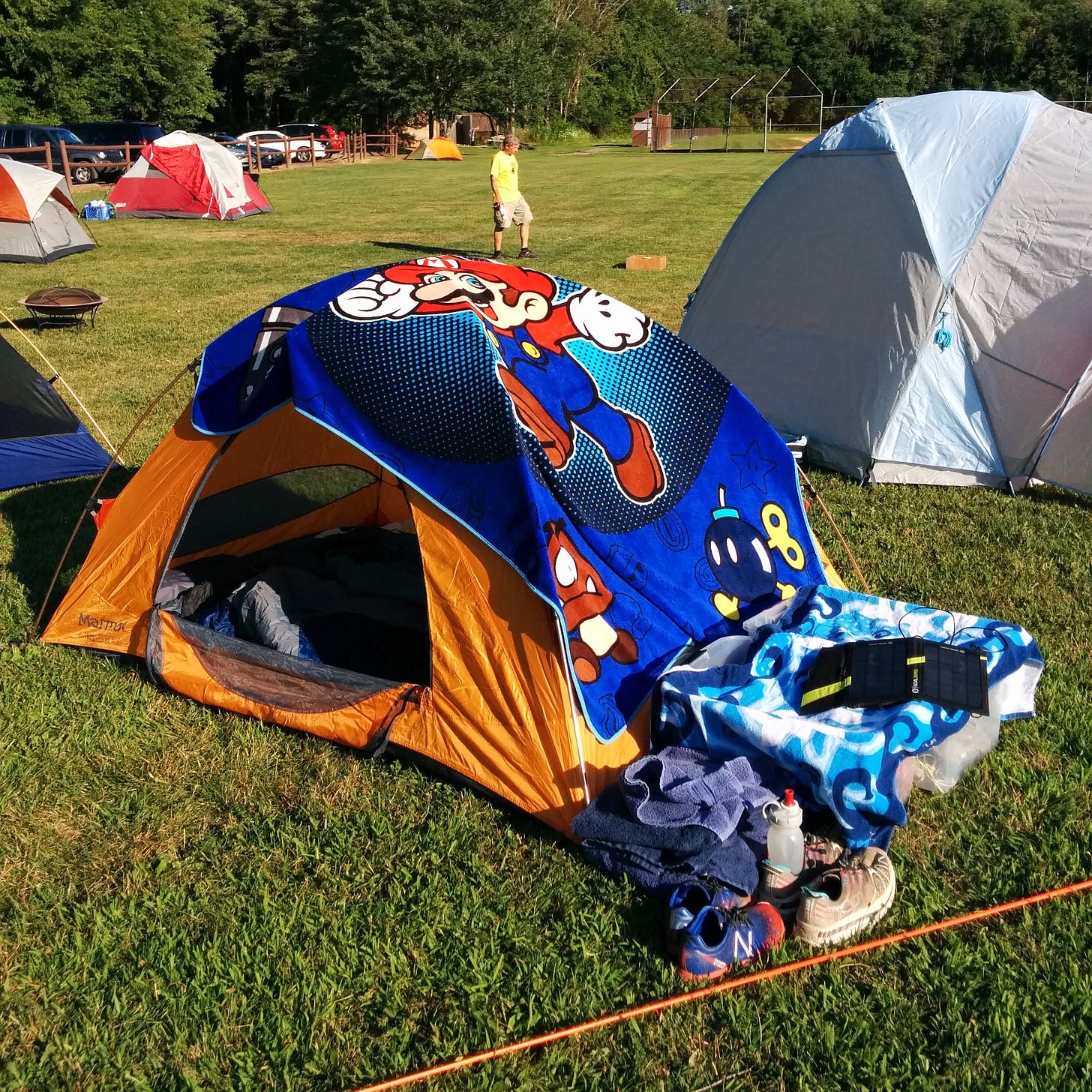

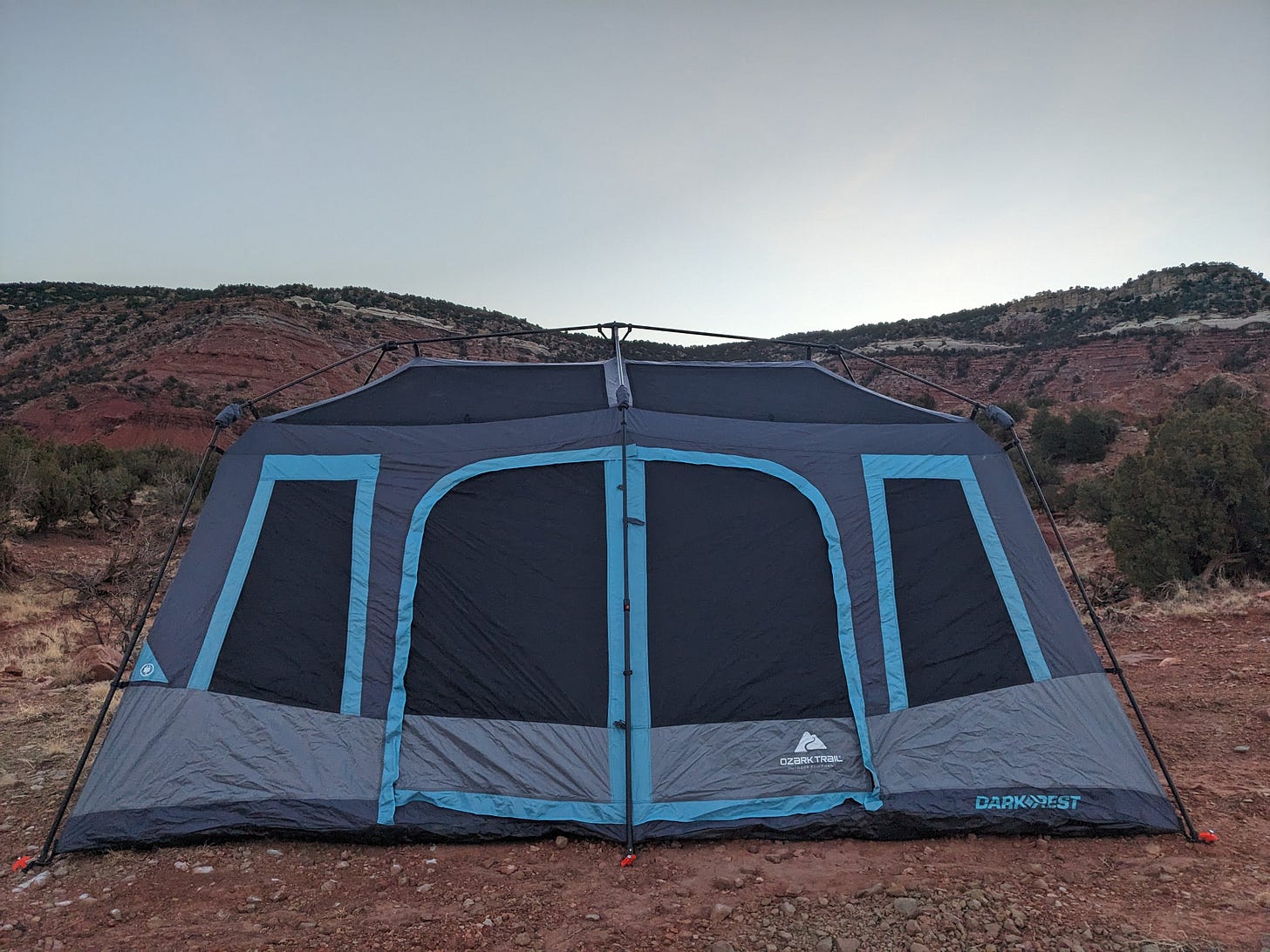
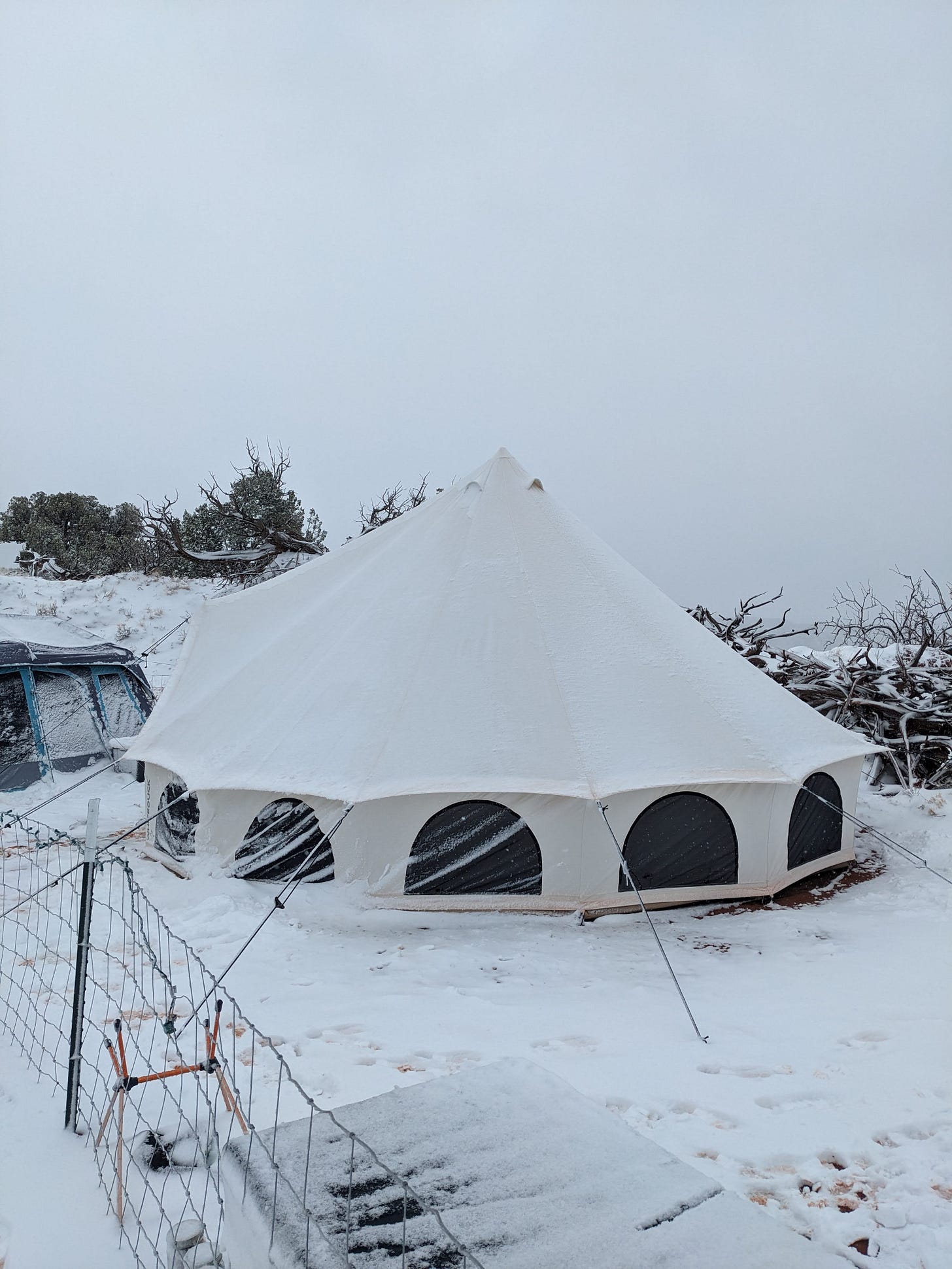
Holly, I’ve only recently discovered your substack so I haven’t had the chance to read a lot of your writing to have much to compare this post to, with that out of the way, I love this post so much! Tents & backpacks are something my husband and I also appreciate having a plethora of! I have many fond feelings for our tents that alway feel like “home” to me in our travels & adventures, whether it’s just for a weekend, cross country road trips or week’s long backpacking. Loved this essay!
What a lovely theme to riff on! I still have (and keep close ~ it’s under my bed in the van, not in the separate trailer which sometimes is hundreds of miles from me) my backpacking Kelty my mama bought me when I graduated high school. I have used it backpacking, road tripping, camping at festivals, overseas… Still the best! (Cool design too, with a fabulous vestibule)
For awhile I had a tent similar to your Blackout – I loved it for festivals because it was so big and breezy. But I loaned it to a friend to take to Burning Man, and he was too embarrassed by its condition afterwards to even let me see it again. (Gratefully, he did pay me for it 😅)
I did have a small Coleman dome for some time too, which was surprisingly delightful. Heavy, but easier to set up than the big one, and more spacious than the backpacking one. Perfect for car camping. I would still have it, but I gave it to my best ex who had Never Owned A Tent! I had to send him off with one… (Hopefully he uses it someday! But we did already have some good times in it ;-)
I’ve gotten a little soft with my cushy #Vanlife, haven’t actually used a tent in awhile… 🥺 But there is something so satisfying about sleeping so close to the earth. (It’s literally grounding.) Thanks for the reminder, the reminisce…
As for the whole topic of homelessness versus nomadic life – that’s a whole can of worms I won’t even open, but I know it so well. I guess if I say one thing, it’s interesting to me how in different places that I live my nomadic ways, I am perceived as either cool, normal, or homeless. It takes a lot of courage and diligence to not take on the projections of the latter one when in those places!
In my own way, I am creatively both on the search for and continually crafting home. I’m appreciating your conversations on this, as it’s always such a relief to remember there are others living out of the box… (and instead in vans, tents, etc 😅)